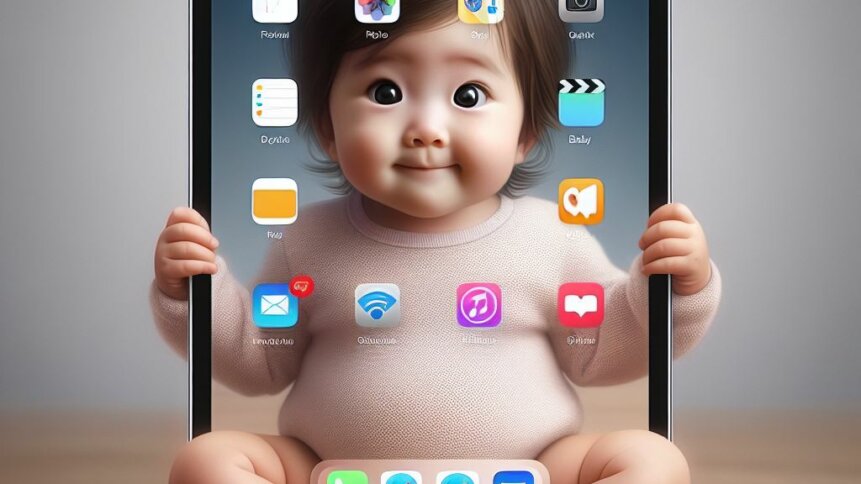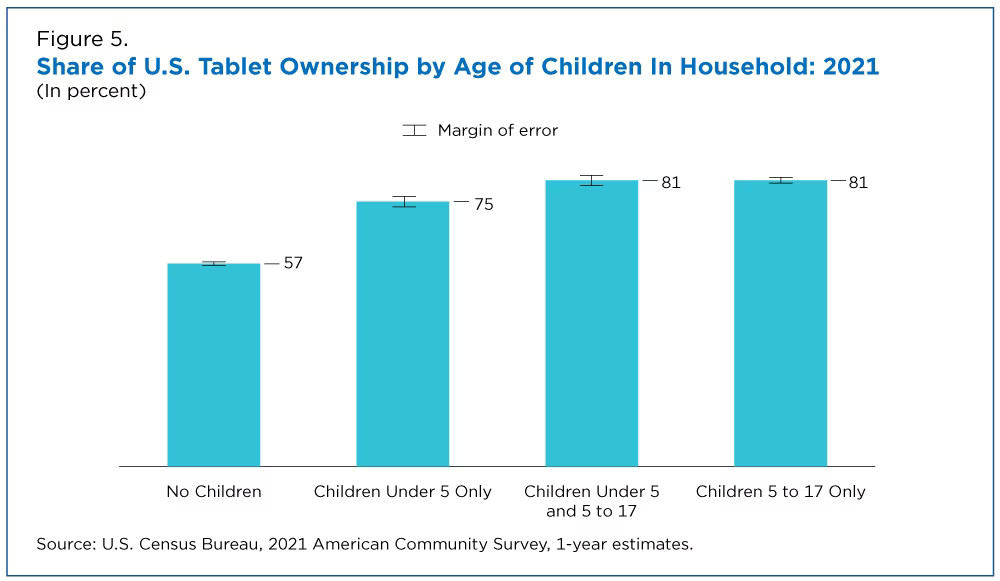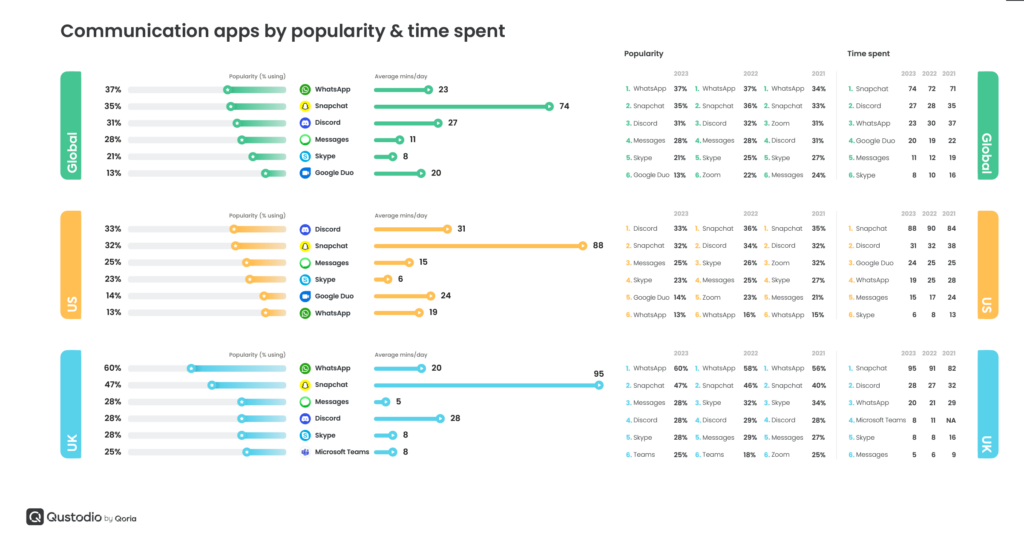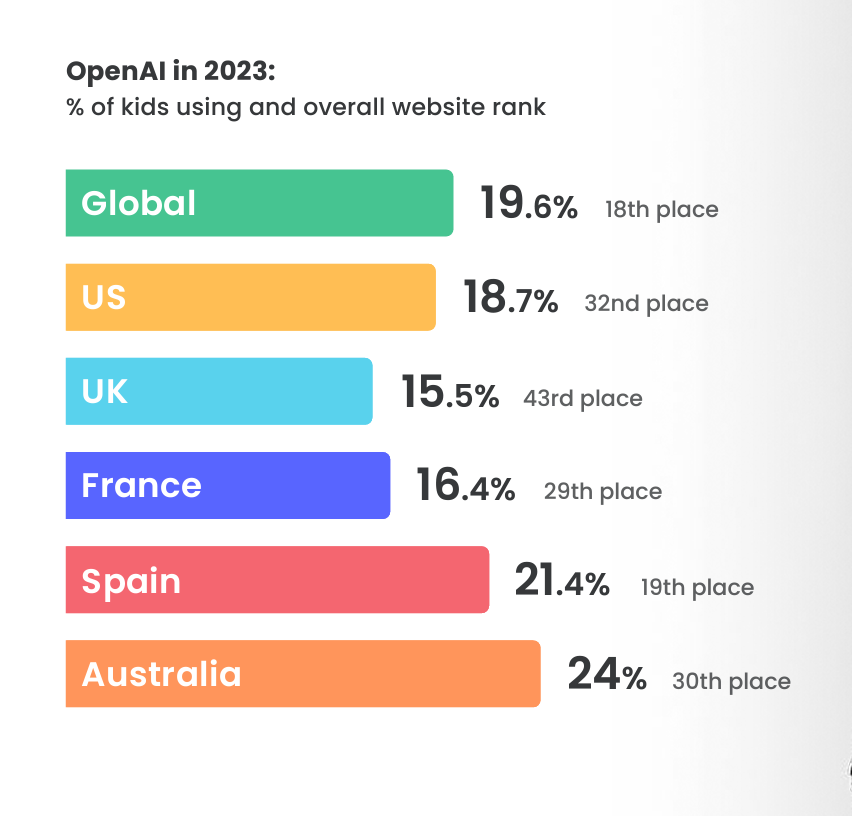How children navigate the internet and technology

- A report on children’s online habits shows how important parental controls can be.
- Kids in America and the UK use TikTok for over two hours every day.
- Parents are more concerned about their child’s online safety than ever before.
Qustodio’s report on children’s use of technology was released today, providing insight into the habits of the generation that’s adapting fastest to emerging technologies. The report investigates how young people use technology, analyzing the apps they use to provide insight into daily habits, as well as emerging trends and ongoing interests.
This year, the title of the report is Born connected: the rise of the AI generation. It looks into how kids and teens used online tools and apps across 2023, comparing their most-loved applications over a three-year period from 2021 to 2023.
The research focuses on children’s app use over five categories: online video, social media, gaming, education, and communication. The report also includes findings from the adults of the family, taking note of their and their kids’ views on how parental controls and technology fit into daily family life.
Qustodio is a global leader in online safety and digital wellbeing for families, and was founded in 2012 by cybersecurity experts Eduardo Cruz, Josep Gaspar, and Josh Gabel.
We are living in a time with no distinction between on and offline; constant access to connectivity means that the internet is no longer confined to the family computer in the corner of the living room. That means technology is now much more convenient – but navigating the dangers that come with it is tricky.
Never before have children been raised with such constant access to the digital world. Children who can carry the internet with them wherever they go – and without a second thought.
The report is based on anonymous app and online tool usage provided from over 400,000 families with children aged 14-19 around the world.
Devices
The iPad kid is often conjured as an example of the way children interact with tech: completely zoned in on headache-causing graphics, grubby and absolutely inconsolable should the device be taken away.
As it turns out, having children in your home makes you more likely to own a tablet. 75% of US families with children under five have one, compared with just 57% among those without kids.

Keep taking the tablets…everywhere you go.
Parental controls are as much a part of family life as the devices that make them necessary, and just over one in four parents think parental controls should be implemented from when a child is under three – the age many toddlers are introduced to screentime in the form of TV, tablets, and YouTube.
Almost 25% of parents believe 7-9 is the right age to start using parental controls with their children, while 22% believe 10-12 is the ideal, coinciding with the average time a child is now given their own cell phone.
To put into context the speed at which technology use is changing for kids, in 2015 less than half (41%) of children owned a phone by age 12. Now, 75% of kids have a phone by 12, and 25% of 10-year-olds have their own phone.

A is for Apple… Photo: The Bump.
Parents ranked the risks that most made them want parental controls in order of most to least worrying. Exposure to adult content or pornography was the main concern, followed by online predation. In the US, 51% of teens report being exposed to porn accidentally by clicking a link, while in the UK online grooming crimes rose by over 80% between 2017 and 2022.
The third most concerning issue for parents was online addiction. 76% of parents assert that parental control tools give them more visibility over their child’s digital life. A further 76% acknowledge that using parental controls helps encourage healthier screen time habits and routines for their family.
Notably, 89% of families use parental controls to filter and block inappropriate content on children’s devices, and 85% to monitor overall screentime. Still – does that stand in for a more collaborative use of the internet?
42% of parents co-watch content with their kids, while only 18% co-play video games. Only 10% of parents sit with their child while they’re using the internet. Just under a third of parents follow their children on social media, and only one in five has ever logged into their child’s social media profile to ensure their online safety.
Carefully treading the line between fair oversight and a child’s privacy, only 7% of parents thought children 15 or younger should use devices with no form of online monitoring. The vast majority feel that 18+ is the age to stop.
In the classroom, 72% of children now use some form of digital device for school: 28% bring their own device from home to school, while 44% use one provided by their school. Classroom technology use growing means there’s increasing need for a school-home connection that keeps kids’ use of educational devices safe and productive.
Changes are evidence of efforts to do this: in Spain an effort has been made to install Digital Wellbeing Coordinators in schools and the UK’s Department of Education has set specific filtering and monitoring standards for students.
Watching online video
Despite streaming price hikes and crackdowns on password sharing, kids’ time on online video platforms increased by 27% compared to 2022. Where they watched shifted too: Netflix use dropped 4%, Disney+ by 23% and Hulu by 12%. All three platforms upped their subscription prices during 2023.
Free services like YouTube and YouTube Kids beat records as screen time on both platforms rose – especially true for content geared towards younger children, with watch time for YouTube Kids rising globally by 14% and hitting a staggering daily average of 96 minutes, the highest number seen since Qustodio’s research began in the Before-Times of 2019.
France and Spain saw the highest YouTube usage (70% and 71% respectively), while only 58% of Australia’s children engaged with the platform.

Popular apps with children and teens – from Qustodio’s annual data report 2023.
Although it lost some loyalty, Netflix remains the most popular paid service among children – a bummer for Disney, presumably. All others, including Disney+, Amazon Prime and Hulu, experienced a popularity dip.
For the second year running, YouTube was the most blocked by parents. Treated by the report as an online video platform, we’d imagine the social side of it is partly why parents are more suspicious of it than Netflix. That and the self-upload capacity; it’s much more difficult to monitor the slew of content that near anyone can post.
Social media – are parental controls enough?
2023 had social media companies in the headline more often than not. TikTok testified in the US court and its Shop feature was banned in Indonesia. With child safety lawsuits presented in the US against both Meta and ByteDance, the UK’s new Online Safety Act, and parental consent legislature for social media in France, the biggest names in social media are up against social and governmental change.
Much of that change is primarily aimed at the younger generations – not that kids seemed to take note of shifting rules around them.
Unsurprisingly, TikTok was the most popular app globally and in almost all countries individually, save Australia, where it drew with X for the number one spot.
44% of children worldwide used TikTok, and even more so in Europe: 1 in 2 children in France and the UK were fans of the eternal scroll, while Spanish children were its biggest users – 61% of under-18s in Spain use TikTok.
As many as 1 in 2 Spanish children use Instagram, which came in second to TikTok in France and Spain but dropped to fifth place globally, with just 32% of kids using it. Still, since the introduction of reels in 2020, the time kids spend on Instagram has risen year on year, rising 40% in the last year from 45mins/day to 63mins/day.
That’s a huge amount of time scrolling, but pales in comparison to the time young people spend on TikTok.
Children worldwide spent 112 minutes on TikTok per day, while in the US, this rose to two hours on TikTok daily – that’s over 180 40-second videos a day, or over 240 30-second clips.
And in the UK, children scrolled for 127 minutes on TikTok every day, almost 100% more than on YouTube in the same year. If you’ve ever looked over a kid’s shoulder while they’re on TikTok, you probably still struggle to imagine how utterly brain-rotting is the content the algorithm serves them.
@d_andrew_g Family Guy Content #familyguy #familyguymemes #fyp #funny #content #sludge #shipost #quagmire #subwaysurfers #slime #satisfying #brickbreaker #minecraft #minecraftmemes
Think scene-cut graphics from 2000s TV crossed with slot machine-style gameplay imagery and a robotic voice reading an inane Reddit post aloud – all at once, three times over – for TWO HOURS a day. For the second year in a row, TikTok was the most blocked content provider among families.
Speaking of Reddit, the platform only got about nine minutes of use per day, the same as X. In Spain, new entry BeReal beat Reddit for those almost-ten minutes a day.
Communication
Arguably the hardest thing for a parent to deny their child is the ability to chat online with their peers. While once being allowed, a later curfew was what kids bargained for. Now there’s less impetus to leave the house – but God forbid you turn off the WiFi or don’t allow your child to download Facebook Messenger.

Parental controls are all very well – but you have to be able to deal with the tsunami of accusation that comes with them.
WhatsApp came in as the most popular communication platform for the third year in a row, with European countries being most WhatsApp-friendly: 67% of Spanish children use it as their preferred method of communication. Meanwhile, in Australia and the US, kids were torn between Snapchat and Discord as their top platform.
Children and AI – the blind leading the blind?

The advent of AI. In the alleged words of Dorothy Parker, “What fresh hell is this?”
There’s also a huge area we’ve neglected to mention: AI. This is, after all, the “AI generation,” but what does that actually mean?
Despite the sudden boom and media frenzy surrounding AI, 2023 was still a year of adoption and discovery for most. Out of the 200 10-13 year-olds surveyed by the report, only 6% said that they actively used AI.
Even at this early stage, it’s undeniable that AI is here to stay; between 2023 and 2030, growth of AI tools is expected to increase by almost 40% per year, and it’s just too universally useful to burn to the ground. However, it’s also impossible to gauge the way children’s digital experience will be affected by it quite yet.
Globally, almost 20% of kids accessed OpenAI in 2023, putting it in 18th place overall for the year’s most-visited websites.
The main takeaway
We can’t begin to cover the full scope of the report. It’s available to read here, where you can also gain some insight into the gaming and educational use of technology among kids. Why would you bother? Well, as parents it’s worth staying ahead of the curve – your kids are already as tech-savvy as you, if not significantly moreso.

This kid’s ability to detect AI lies might be better than most of silicon valley….
The habits of the next generation are also a way of forecasting how the world will look in ten, or even just five years’ time.
When Qustodio’s research began, screen time was the main concern for families. Over time, it’s taken a backseat and allowed worries about online safety to take over. Concerned about the long-term effects of technology, families are talking more about mental health, accompanying kids more closely on their digital journeys, and using tools to keep them safe.









